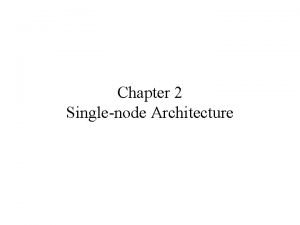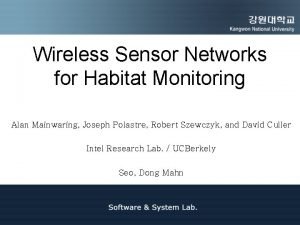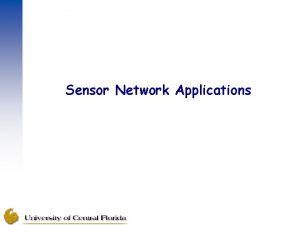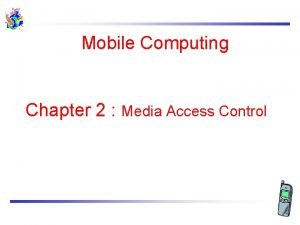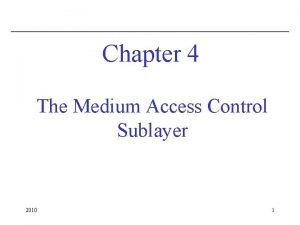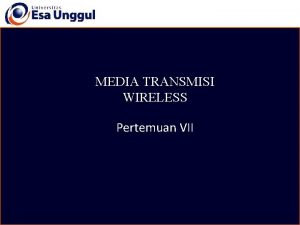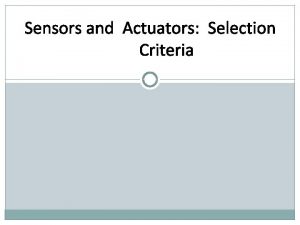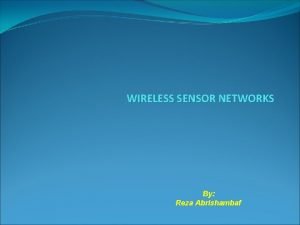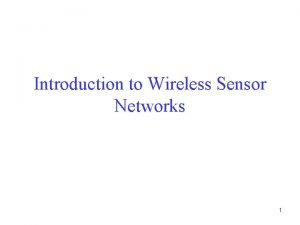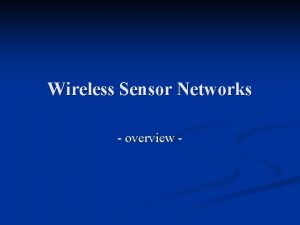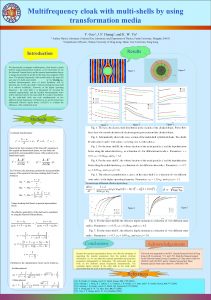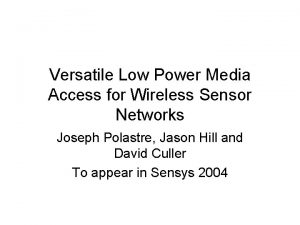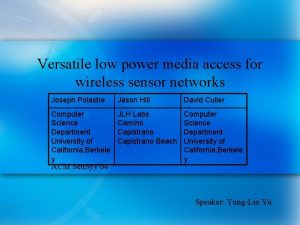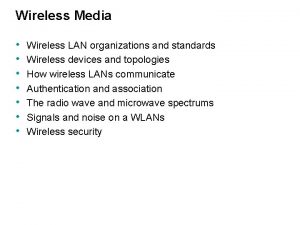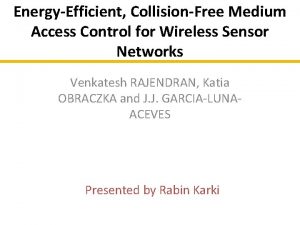MMSN MultiFrequency Media Access Control for Wireless Sensor






















- Slides: 22

MMSN: Multi-Frequency Media Access Control for Wireless Sensor Networks Cheoleun Moon Computer Science Div. at KAIST /

Contents o o o Motivation Overhead Analysis New Protocol Framework n n o o Frequency Assignment Media Access Design Performance Evaluation Conclusions 2

Ad-hoc Wireless Sensor Networks n Self-organize n n Sensors & Actuators Limited CPU and memorys Limited radio bandwidth 3

Motivation Limited single-channel bandwidth in WSN o n 19. 2 kbps in MICA 2, 250 kbps in MICAz/Telos The bandwidth requirement is increasing o n Support audio/video streams (assisted living, …) Multi-channel design needed Hardware appearing Multi-channel support in MICAz/Telos n More frequencies available in the future n Software still lags behind Collision-based: B-MAC n Scheduling-based: TRAMA n Hybrid: Z-MAC n 4

Multi-Channel MAC in MANET o Require more powerful hardware/multiple transceivers n o Listen to multiple channels simultaneously Frequent Use of RTS/CTS Controls n n For frequency negotiation Due to using 802. 11 5

Basic Problems for WSN o Don’t use multiple transceivers n n o Packet Size n o Energy Cost 30 bytes versus 512 bytes in MANET RTS/CTS n Costly overhead 6

RTS/CTS Overhead Analysis o RTS/CTS are too heavyweight for WSN: n n n Mainly due to small packet size: 30~50 bytes in WSN vs. 512+ bytes in MANET From 802. 11: RTS-CTS-DATA-ACK From frequency negotiation: case study with MMAC o MMAC n n RTS/CTS frequency negotiation 802. 11 for data communication 7

Contributions o First multi-frequency MAC, specially designed for WSN o Developed four frequency assignment schemes n o Supports various tradeoffs New toggle transmission and toggle snooping for media access control 8

Frequency Assignment F 8 Reception Frequency F 7 F 6 F 5 F 1 F 4 Complications - Not enough frequencies - Broadcast F 2 F 3 9

Frequency Assignment Schemes When #frequencies >= #nodes within two hops Exclusive Frequency Assignment o o o When #frequencies < #nodes within two hops Implicit-Consensus Both guarantee that nodes within two hops get different frequencies The left scheme needs smaller #frequencies The right one has less communication overhead Even Selection o o o Eavesdropping Balance available frequencies within two hops The left scheme has fewer potential conflicts The right one has less communication overhead 10

Media Access Design (1/4) o o o Different frequencies for unicast reception The same frequency for broadcast reception Time is divided into slots, each of which consists of a broadcast contention period and a transmission period Tbc Ttran …. . . Tb c Ttran 11

Media Access Design (2/4) o Case 1 n When a node has no packet to transmit 12

Media Access Design (3/4) o Case 2 n When a node has a broadcast packet to transmit 13

Media Access Design (4/4) o Case 3 n When a node has a unicast packet to transmit 14

Toggle Snooping o During “back off (fself, fdest)”, toggle snooping is used 15

Toggle Transmission o When a node has unicast packet to send transmits a preamble n n fself so that no node sends to me fdest so that no node sends to destination 16

Simulation Configuration Components Setting Simulator Glo. Mo. Sim Terrain (200 m X 200 m) Square Node Number 289 (17 x 17) Node Placement Uniform Payload Size 32 Bytes Application Many-to-Many/Gossip CBR Streams Routing Layer GF MAC Layer CSMA/MMSN Radio Layer RADIO-ACCNOISE Radio Bandwidth 250 Kbps Radio Range 20 m~45 m Confidence Intervals The 90% confidence intervals are shown in each figure 17

Performance Metrics o Aggregate MAC throughput n o Packet delivery ratio n o (Total # of data packets delivered by MAC layer) (Total # of data packet the network layer requests MAC) Channel access delay n o Total amount of data successfully delivered in MAC per unit time Delay data packet from the network layer waits for the channel Energy consumption 18

Performance with Different #Physical Frequencies – With Light Load ① ② ③ ④ Performance when delivery ratio > 93% Scalable performance improvement Overhead observed when #frequency is small More scalable performance with Gossip than many-to-many traffic 19

Performance with Different # Physical Frequencies – With Higher Load ① When load is heavy, CSMA has 77% delivery ratio, while MMSN performs much better ② MMSN needs less channels to beat CSMA, when the load is heavier 20

Performance with Different System Load Observation: CSMA has a sharp decrease of packet delivery ratio, while MMSN does not. Reason: The non-uniform backoff in time-slotted MMSN is tolerant to system load variation, while the uniform backoff in CSMA is not. 21

Conclusions o First multi-frequency MAC, specially designed for WSN, where singletransceiver devices are used n n n Explore tradeoffs in frequency assignment Design toggle transmission and toggle snooping MMSN demonstrated scalable performance in simulation 22
 Wired data transfer
Wired data transfer Wireless sensor network protocols
Wireless sensor network protocols Single node architecture in wsn
Single node architecture in wsn Alan mainwaring
Alan mainwaring Telosb
Telosb Geoves butterfly wireless multi sensor
Geoves butterfly wireless multi sensor Sst wireless
Sst wireless Wireless sensor networks for habitat monitoring
Wireless sensor networks for habitat monitoring What are wireless devices and the wireless revolution
What are wireless devices and the wireless revolution Terminal access controller access control system plus
Terminal access controller access control system plus Terminal access controller access-control system
Terminal access controller access-control system Media access control methods
Media access control methods Mac media access control
Mac media access control Spread aloha multiple access in mobile computing
Spread aloha multiple access in mobile computing Gpon dba
Gpon dba Medium access control sublayer
Medium access control sublayer Wireless guest access solution
Wireless guest access solution Toast meraki
Toast meraki Wireless access point attack vector
Wireless access point attack vector Wireless access solutions
Wireless access solutions Arduino servo ultrasonic sensor code
Arduino servo ultrasonic sensor code Wireless control system
Wireless control system Media transmisi wireless
Media transmisi wireless


